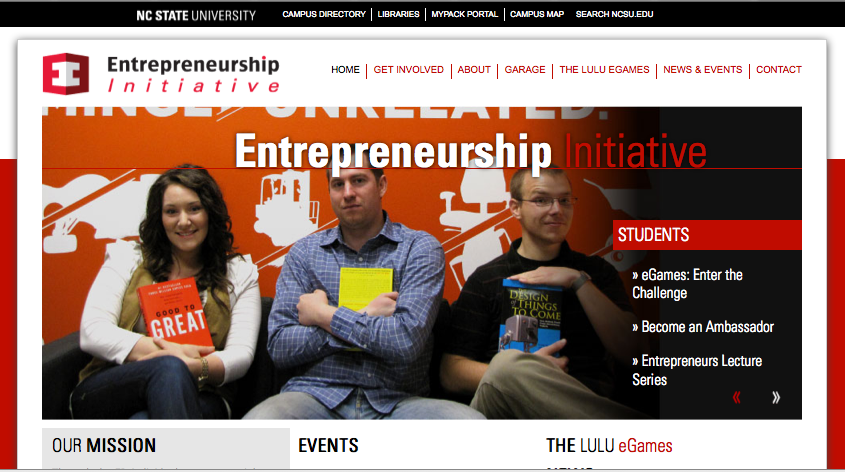Cultivating an Entrepreneurial Community as a Student Leader
By Sean Newman Maroni
Building a university entrepreneurial community is unlike any other student leadership role. As a student leader of NC State’s Entrepreneurship Initiative for the last three years, I’ve learned a lot about sparking entrepreneurship and why many university entrepreneurship programs fail. This article is the first of a 12-part series on cultivating thriving innovation ecosystems in the often constraining university environment.
Humans (and College Students) Don’t Scale
If you are a student leader, you will learn this lesson sooner than most. To make a dent in the way your campus operates, you will quickly find that time is your scarcest resource. Being any kind of student leader inevitably intensifies the college student lament about the zero-sum game of balancing sleep, grades, and a social life.
When I started helping build our community, my triangle was engineering classes, entrepreneurial endeavors of my own, and planning events. Minimizing sleep felt like some sort of badge of honor, and my “reality distortion field” worked to soothe the academic concerns of my parents. These sacrifices seemed warranted because as “President” of the EI community, I felt it was my responsibility to do everything I could to make things happen. But despite the time investment, too many of my initiatives could be summed up with “at least there was pizza.”
It became clear that something needed to change.
After reading a few good books, watching hours of Stanford eCorner videos, and reflecting, I decided to try to remove the “I and me” from the equation. I had mistakenly conflated the fancy “President” title with my importance, and as a result limited the potential of people around me. Unfortunately, entrepreneurship’s past is filled with great ideas that died due to a similar arrogance of leadership. Steve Jobs explains his own struggles with this concept here.
As a student leader, you have a unique opportunity to avoid developing the habits of ego and hubris that can squander a group’s potential. If you give someone responsibility and trust, their IQ will miraculously double.
Autocatalysis
What do chemical reactions have to do with event planning?
It turns out more than you think.
An autocatalytic reaction occurs when the output of the reaction contains the inputs of that same reaction. What makes these reactions so cool is that if you have the basic input ingredients for one reaction to occur, a self-sustaining and possibly accelerating chain of activity ensues. This idea is used by tech startups in the form of “network effects” to accelerate growth. The explosion of a viral video is autocatalytic because one “share” leads to more shares, which in turn leads to still more sharing.
Your main focus in creating new events and initiatives should be to integrate autocatalysis. This is how it is possible to grow a community without letting it consume all of your time.
For example, we once built something called an eBoard as a way of spreading the word about our events. It’s a giant free standing whiteboard that we place in the middle of high traffic areas to market events. Back when I was the only person that deployed the eBoard, it saw the light of day 2-3 times a semester. Now, we allow anyone in the EI community to check out the eBoard to promote their own projects. This leads to even more people discovering our innovation space, attending events, and in even turn more people using the eBoard.
We’ve also created an autocatalytic “Community Office Hours” program. We started this when we noticed that entrepreneurs are highly interested in connecting with students, sharing insights, and offering them opportunities. To start this program, I invited a local attorney to work out of our innovation space, “The Garage,” for a few hours on a Friday afternoon. I posted on our facebook group and sent out an email that he would be in the Garage to offer free legal advice from 3-5 pm, and that anyone was welcome to show up. The first session went well, so I welcomed him to post on our facebook group anytime he planned to hold hours. He shared this with other local feeders to the entrepreneurial community, and it’s taking off. This program only required one meeting and few emails to set up, yet it’s been quite valuable. By giving trusted community members direct access to our channels, I’ve removed myself as a bottleneck for serendipitous entrepreneurship to happen. We are experimenting with even more autocatalysis by getting students to start holding their own office hours.
I encourage you to think of unique ways to make events self-sustaining; there is truly no limit to how big you can go.
Steps to Starting Autocatalytic Events
1. Listen. In community building, your target market is all around you. Consistently seek out the opinions of others to understand what they’d like to see happen. If someone voices enthusiasm for creating something, ask if they would like to take the lead on making it happen.
2. Design with the end in mind. Since your goal is to create self-sustaining events, think of unique ways to integrate autocatalysis and empower many community members to take ownership of its success.
3. Actively Create The First Reaction. If you are the lead person on a project, it is your job to be the catalyst that begins the chain reaction. Pinpoint the essential tasks that must be completed to go from idea to first iteration, and proceed to execute, taking every opportunity to engage your team’s unique skills.
4. Empower a “DRI.” After the first iteration of a new program, identify a “Directly Responsible Individual” who is interested in sustaining that event in the future. Ideally, this is the person who came up with the idea, or contributed the most so far. Trust this person to execute, and be prepared to support them when needed. Even if you have a fancy title like “President,” it’s your job to support, not control a DRI. DRI’s are responsible for the day to day things that need to be done to make something happen, and perpetually improving the quality of that initiative.
5. Manage the sun and the rain, but let the plants do their thing. Let DRI’s and the community shape the budding events and spend your time ensuring the fundamental ingredients of an entrepreneurial culture are in place. Entrepreneurship is inevitable if all the right inputs are present, but dies if any input is missing for too long. A few of these include a rich talent density, communal acceptance of new ideas and participants, cross-disciplinary perspectives, a “failure = learning” mindset, and using reciprocity as a currency of opportunity.
6. Know that not everything will work. If you are confident that the right ingredients are in place, but a certain event is still not working, it’s ok to let it go. There is an element of natural selection in community building; if the community doesn’t find something valuable it’s ok to let it die.
The role of a community builder is to create the conditions for entrepreneurship to happen. Work to put the right people, resources, and entrepreneurship mindset in place, but trust the people around you to build on that foundation. After giving up control and reframing my role, our community has doubled in size, we’ve launched more companies, had a lot more fun, and I’ve actually received more (undeserving) recognition than when I was trying to do it all myself. No man is an island; the entire community must help craft an ecosystem to be proud of.
This article is the first in a series of writings on creating thriving university innovation ecosystems.
 Sean Newman Maroni is a senior in mechanical engineering at North Carolina State University. He is a Student Ambassador and the co-founder of BetaVersity, a startup specializing in building and supporting innovation ecosystems (see our blog post on it here). Sean can be reached at Sean@BetaVersity.com, and can be found writing about the amplification of human potential at RefuseToPeak.com
Sean Newman Maroni is a senior in mechanical engineering at North Carolina State University. He is a Student Ambassador and the co-founder of BetaVersity, a startup specializing in building and supporting innovation ecosystems (see our blog post on it here). Sean can be reached at Sean@BetaVersity.com, and can be found writing about the amplification of human potential at RefuseToPeak.com










Trackbacks & Pingbacks
[…] Cultivating an Entrepreneurial Community as a Student Leader (studentambassadorsusa.com) […]
Leave a Reply
Want to join the discussion?Feel free to contribute!